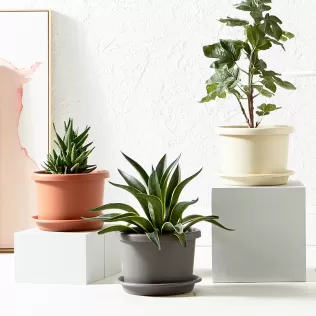How to Choose the Right Size of Plastic Flower Pot for Different Plant Types?
In the world of gardening, selecting the appropriate size of plastic flower pot for your plants is a crucial decision. The size of the pot can significantly impact the health and growth of your beloved plants. Whether you're an experienced gardener or just starting your green journey, it's essential to understand the factors that influence your choice of flower pot size for different plant types. In this comprehensive guide, we'll delve into the intricacies of pot selection, helping you make informed decisions that can lead to thriving plants and a stunning garden.

Understanding Plant Growth Requirements
Before we dive into the specifics of choosing the right size of plastic flower pots, it's imperative to grasp the fundamental requirements of various plant types. Different plants have distinct growth patterns and needs, such as root space, moisture, and nutrients. Here are some common plant categories and their growth characteristics:
Herbs and Small Plants
Herbs like basil, mint, and parsley, as well as small flowering plants, have relatively shallow root systems. They thrive in smaller pots and do not require excessive space. A pot with a diameter of 6 to 8 inches should suffice for most small plants.
Vegetables
Vegetables vary in size and root depth. While leafy greens like lettuce can thrive in compact pots, larger vegetables like tomatoes or peppers need more substantial containers. A pot with a diameter of 12 to 18 inches is suitable for most vegetable plants.
Succulents and Cacti
Succulents and cacti are known for their low-maintenance nature. They have shallow root systems and can thrive in small pots, usually ranging from 2 to 6 inches in diameter.
Trees and Shrubs
Trees and shrubs require larger pots due to their extensive root systems. The size of the pot will depend on the specific tree or shrub species, but typically, you'll need a container with a diameter of 24 inches or more.
Indoor Plants
Indoor plants come in various sizes, but most of them can thrive in smaller pots. A pot with a diameter of 4 to 10 inches is usually sufficient for common indoor plants like pothos or snake plants.
Factors to Consider When Choosing Pot Size
Now that we have a basic understanding of plant categories and their growth requirements, let's explore the essential factors to consider when selecting the right size of flower plastic pot:
1. Root Space
One of the primary considerations is providing adequate space for the plant's roots to grow. When roots become crowded, it can lead to stunted growth and reduced nutrient absorption. As a rule of thumb, choose a pot that offers at least 2 inches of space around the root ball for small plants and up to 6 inches for larger ones.
2. Drainage
Proper drainage is crucial to prevent overwatering and root rot. Ensure that your chosen pot has drainage holes at the bottom. If your pot doesn't have them, consider drilling holes or using a pot with a removable saucer to allow excess water to escape.
3. Plant Growth Stage
Consider the growth stage of your plant. If it's a young plant, you can start with a smaller pot and repot it as it grows. Conversely, mature plants may require larger containers to accommodate their established root systems.
4. Climate
The local climate can influence your choice of pot size. In hot, dry climates, larger pots can help retain moisture for longer, while in humid regions, smaller pots may be sufficient.
5. Aesthetic Appeal
Don't forget the aesthetic aspect of gardening. Choose a pot that complements your garden's design and enhances its visual appeal. There's a wide range of plastic flower pot designs and colors available to suit your style.
Repotting Guidelines
As your plants grow, they may outgrow their current pots, necessitating repotting. Here's a quick guide on when and how to repot your plants:
Observe the Roots: If you notice roots coming out of the drainage holes or circling the pot's surface, it's time to repot.
Choose a Bigger Pot: Select a new plastic flower pot that is 2 inches larger in diameter than the current one.
Transplant with Care: Gently remove the plant from its current pot, loosen the roots, and place it in the new pot with fresh potting mix.
Water Thoroughly: After repotting, water your plant thoroughly to help it adjust to its new home.
Conclusion
Choosing the right size of plastic flower pot is an essential aspect of successful gardening. By understanding the specific needs of your plants, considering factors like root space, drainage, growth stage, climate, and aesthetics, you can create an optimal environment for your green companions to flourish.
Remember that each plant is unique, so take the time to research the specific requirements of the plants in your care. With the right pot size and proper care, your garden will be a thriving oasis of beauty and vitality.
452
0
0


Comments
All Comments (0)